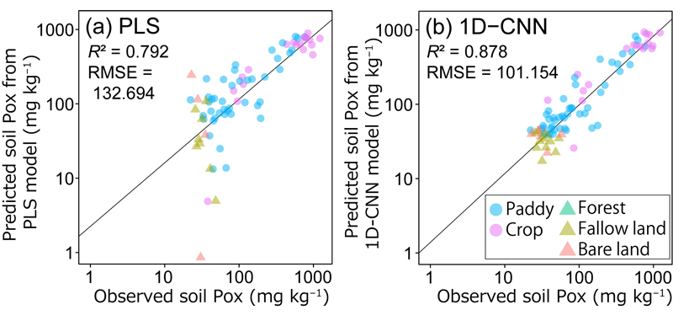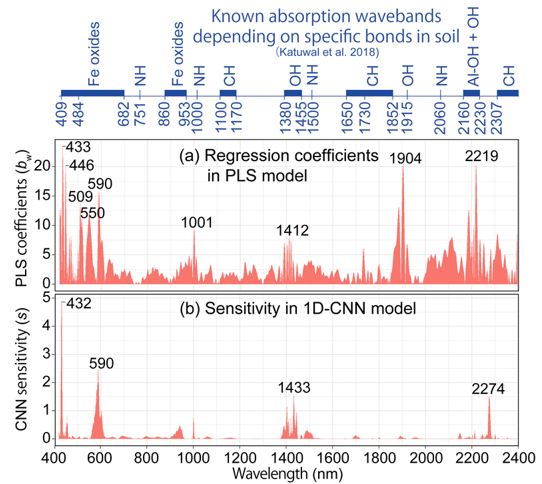A model for estimating soil phosphorus availability in diverse tropical ecosystems by deep learning
Description
Since soil phosphorus (P) availability is low in tropical regions, it is necessary to accurately assess the soil P availability and implement appropriate nutrient management to realize sustainable crop production and land use. So far, we have developed a method to rapidly assess oxalate-extractable P (Pox) using visible and near-infrared (Vis-NIR) spectroscopy (JIRCAS Research Highlights 2019: “Soil phosphorus availability for rice plants can be rapidly estimated by laboratory visible and near-infrared spectroscopy”). However, this method based on partial least squares (PLS) regression strongly depends on the spectral characteristics of the training dataset, and thus, building a single model is difficult in soils with different land uses (paddy fields, crop fields, forests, etc.) and meteorological conditions. On the other hand, deep learning, in which the machine automatically discriminates wavelength characteristics, can develop a comprehensive model independent from land use. Deep learning requires a large amount of training data, but higher predictive accuracy than PLS regression can be expected. In this study, we aimed to develop a single model for estimating soil Pox in various tropical ecosystems by deep learning of spectral data.Soil samples (n = 318) were collected from the surface layer (0–15 cm depth) in rice fields, crop fields, forests, fallow lands, and bare lands in the east coast and the central highlands of Madagascar (110–1,667 m above sea level). The spectral data was measured in the Vis-NIR region (400–2400 nm) in a dark room using a portable spectroradiometer (FieldSpec, ASD Inc.) for 2 mm sieve-passing air-dried soil. The content of soil available P was determined by acid ammonium oxalate method (Pox). The deep learning model trained the relationship between spectral data and soil Pox content using a one-dimensional convolutional neural network (1D-CNN). The 1D-CNN model can be applied to soil Pox estimation for diverse ecosystems, and its accuracy (R2 = 0.878) is higher than that of PLS model (R2 = 0.792) (Fig. 1). Based on the sensitivity analysis, the 1D-CNN model has high sensitivity of related wavebands (432, 590, 1433 nm) of iron oxide and water content in the soils, which are in line with PLS regression coefficients. This result suggests that these wavebands are strongly associated with the soil Pox estimation across diverse ecosystems (Fig. 2).
The developed 1D-CNN model using soil spectral data enables safe and quick estimation of soil Pox without chemical analysis, and can be used for designing optimum fertilizer application. Since the dataset for the current model covers a range of soil types and elevations in the tropics, the model can be also applied to tropical regions other than Madagascar.
Figure, table
-
Fig. 1. Relationship between observed and predicted values of soil oxalate-extractable phosphorus (Pox) using (a) PLS model and (b) 1D-CNN model
The x- and y-axes are displayed on a log scale. RMSE: Root mean squared error. -
Fig. 2. (a) Regression coefficients in PLS model and (b) sensitivity in 1D-CNN model
Red lines and numbers: Importance and wavelength in the estimation of soil availability (Pox). Fe oxides are the absorption wavelengths of iron oxide. OH is the absorption wavelength of the water content.Figures reprinted/modified with permission from Kawamura et al. (2021).
- Classification
-
Research
- Research project
- Program name
- Term of research
-
FY 2017–2022
- Responsible researcher
-
Kawamura Kensuke ( Social Sciences Division )
Nishigaki Tomohiro ( Crop, Livestock and Environment Division )
KAKEN Researcher No.: 80795013Andriamananjara Andry ( University of Antananarivo )
Rakotonindrina Hobimiarantsoa ( University of Antananarivo )
Tsujimoto Yasuhiro ( Crop, Livestock and Environment Division )
ORCID ID0000-0001-7738-9913KAKEN Researcher No.: 20588511Rabenarivo Michel ( University of Antananarivo )
Razafimbelo Tantely ( University of Antananarivo )
ORCID ID0000-0003-2101-9715 - ほか
- Publication, etc.
-
Kawamura et al. (2021) Remote Sensing 13: 1519https://doi.org/10.3390/rs13081519
- Japanese PDF
-
2021_B10_ja.pdf421.92 KB
- English PDF
-
2021_B10_en.pdf233.62 KB
- Poster PDF
-
2021_B10_poster.pdf317.52 KB
* Affiliation at the time of implementation of the study.


